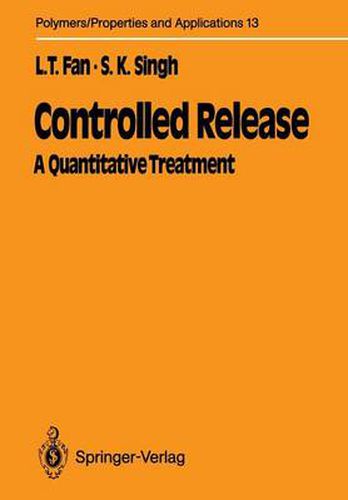Readings Newsletter
Become a Readings Member to make your shopping experience even easier.
Sign in or sign up for free!
You’re not far away from qualifying for FREE standard shipping within Australia
You’ve qualified for FREE standard shipping within Australia
The cart is loading…






This title is printed to order. This book may have been self-published. If so, we cannot guarantee the quality of the content. In the main most books will have gone through the editing process however some may not. We therefore suggest that you be aware of this before ordering this book. If in doubt check either the author or publisher’s details as we are unable to accept any returns unless they are faulty. Please contact us if you have any questions.
The concept of controlled release has attracted increasing attention over the last two decades, with the applications of this technology proliferating in diverse fields in cluding medicine, agriculture and biotechnology. Research and developmental efforts related to controlled release are multiplying in both industry and academia. The reason for this phenomenal growth is obvious. The use of a variety of biologically active agents, such as drugs, fertilizers and pesticides, has become an integral part of modern society. Along with the use of these reagents has evolved an awareness that their uncontrolled application almost inevitably induces harmful effects on the health of humans and their surrounding environments. To eliminate or minimize these harmful effects necessitates the controlled release of these chemicals. Moreover, the controlled release of substances, not usually considered toxic or hazardous, e.g., some catalysts and nutrients, can enhance their effectiveness. The number and variety of controlled release systems, differing in their physical and chemical makeup, are increasing rapidly. Proliferation almost always demands correlation, generalization and unification; it requires both the development of underlying theories of their behavior and the mechanistic interpretation of their performance. This, in turn, requires a statistical and mathematical (quantitative) treatment of the scientific information and technical data pertaining to them. A quantitative treatment can also facilitate the formulation of procedures for computer-aided design of these systems through a priori prediction of their per formance for a variety of design parameters.
$9.00 standard shipping within Australia
FREE standard shipping within Australia for orders over $100.00
Express & International shipping calculated at checkout
This title is printed to order. This book may have been self-published. If so, we cannot guarantee the quality of the content. In the main most books will have gone through the editing process however some may not. We therefore suggest that you be aware of this before ordering this book. If in doubt check either the author or publisher’s details as we are unable to accept any returns unless they are faulty. Please contact us if you have any questions.
The concept of controlled release has attracted increasing attention over the last two decades, with the applications of this technology proliferating in diverse fields in cluding medicine, agriculture and biotechnology. Research and developmental efforts related to controlled release are multiplying in both industry and academia. The reason for this phenomenal growth is obvious. The use of a variety of biologically active agents, such as drugs, fertilizers and pesticides, has become an integral part of modern society. Along with the use of these reagents has evolved an awareness that their uncontrolled application almost inevitably induces harmful effects on the health of humans and their surrounding environments. To eliminate or minimize these harmful effects necessitates the controlled release of these chemicals. Moreover, the controlled release of substances, not usually considered toxic or hazardous, e.g., some catalysts and nutrients, can enhance their effectiveness. The number and variety of controlled release systems, differing in their physical and chemical makeup, are increasing rapidly. Proliferation almost always demands correlation, generalization and unification; it requires both the development of underlying theories of their behavior and the mechanistic interpretation of their performance. This, in turn, requires a statistical and mathematical (quantitative) treatment of the scientific information and technical data pertaining to them. A quantitative treatment can also facilitate the formulation of procedures for computer-aided design of these systems through a priori prediction of their per formance for a variety of design parameters.